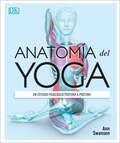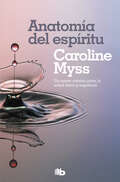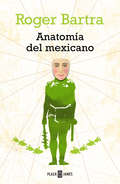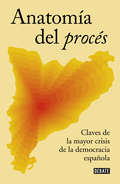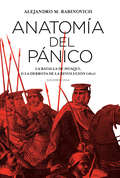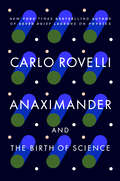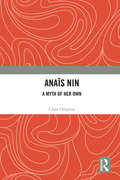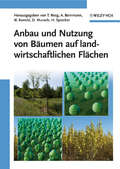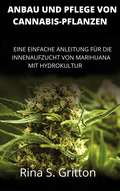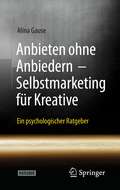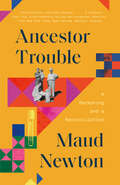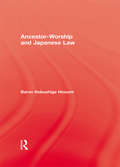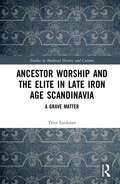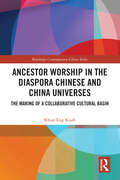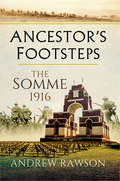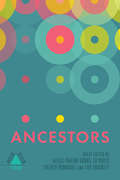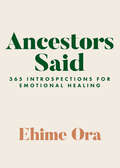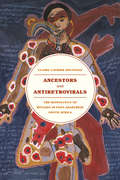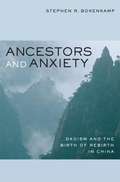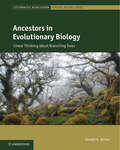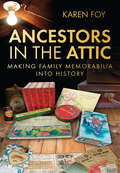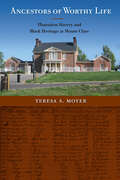- Table View
- List View
Anatomía del Yoga (Science of Yoga): Un estudio fisiológico postura a postura
by Ann SwansonExplora la anatomía de 30 poses de yoga clave y adquiere confianza y control en tu práctica del yoga.Lleva tus conocimientos de yoga al siguiente nivel con este innovador recurso visual de 360 grados, hecho para principiantes que quieren entender las posturas de yoga, así como para profesionales y profesores de yoga que quieren dar instrucciones precisas en sus clases sobre esta disciplina.Investigaciones científicas recientes ahora respaldan lo que alguna vez fueron afirmaciones anecdóticas sobre los beneficios del yoga para todos los sistemas del cuerpo. Anatomía del yoga revela los hechos, con interesantes anotaciones que muestran la mecánica, los ángulos, cómo se ven afectados el flujo sanguíneo y la respiración, la activación de los músculos y las articulaciones que trabajan en cada pose de yoga, y mucho más.Para cada una de las 30 posturas, ilustraciones anatómicas a todo color acompañadas de texto muestran explicaciones concisas sobre las claves para dominar cada asana y sus beneficios.Explora la fisiología de 30 posturas de yoga clave, en profundidad y desde todos los ángulosEn este magnífico libro de yoga cada postura viene acompañada por sugerencias para variarla, de manera que personas de todos los niveles y aptitudes físicas puedan practicarla de manera segura y eficaz.Además, se incluye una sección de preguntas y respuestas que explora la ciencia detrás de cada aspecto del yoga. No busques más allá de Anatomía del yoga para lograr la excelencia técnica en su práctica y optimizar y compartir los beneficios del yoga para el cuerpo y la mente.Entiende todas las claves del yoga y lleva tus conocimientos sobre esta disciplina al siguiente nivel a lo largo de los siguientes capítulos: • Anatomía humana • Las posturas • Sentadas • De pie • Invertidas • En el suelo • Preguntas y respuestas Anatomía del Yoga, es nuestra edición en español de Science of Yoga y pertenece a la colección Gran Formato (estilo de vida) de la editorial DK, un rincón de nuestro catálogo reservado para el público adulto donde encontrarás grandes libros de historia, ciencia, cultura y muchas otras materias de referencia que convierten esta colección en una de las más variadas y extensas de nuestro catálogo.Cuidados diseños e imágenes reclaman la atención del lector y lo acompañan en el conocimiento de esta magnífica y sugerente recopilación de libros que no dejará indiferente a nadie.
Anatomía del espíritu: La curación del cuerpo llega a través del alma
by Caroline MyssCombinando diversas creencias para discutir la salud y la anatomía, la autora de Las siete moradas trata en este libro los sacramentos cristianos, los chakras hindús y el árbol de la vida del Kábala para determinar las siete regiones de energía que posee el cuerpo humano. Tarde o temprano, todos los seres enfermamos y el dolor reduce nuestra capacidad para el trabajo el placer, llegando incluso a arrebatarnos la vida. Sin embargo, pocas son las personas conscientes de que la enfermedad aparece cuando malgastamos nuestra energía, permitimos que nos la roben o la encarrilamos hace objetivos erróneos. Comprenderlo así nos abre el camino de la autocuración, un milagro posible si interpretamos las dolencias del cuerpo como lo que de verdad son: expresiones de un malestar espiritual que tiene curación.
Anatomía del espíritu: La curación del cuerpo llega a través del alma
by Caroline MyssEl long seller que nos enseña que la curación del cuerpo llega a través del alma. El aclamado programa de sanación a través de los siete pilares del poder energético. Este mítico libro resume más de dos décadas de investigación de Caroline Myss, una de las mayores voces de la espiritualidad mundial, en el campo de la medicina energética. En él muestra cómo cada enfermedad responde a un patrón de estrés emocional y psicológico vinculado a distintas áreas del cuerpo humano. Pero también ofrece un revolucionario programa que sintetiza la antigua sabiduría de tres religiones (los sacramentos cristianos, los chakras hindúes y el árbol de la vida de la Cábala) para demostrar los siete puntos energéticos de nuestro cuerpo, sus correspondencias y el modo en que nos afectan sus disfunciones. Al descubrirlo, se abre el camino de la autocuración, un milagro que muestra cómo interpretar las dolencias físicas y desarrollar los poderes latentes de la intuición para cultivar el crecimiento espiritual.. Reseña:«Una de las mejores voces de la espiritualidad.»Publishers Weekly
Anatomía del mexicano
by Roger BartraLa cultura mexicana del siglo XX inventó un ser nacional cuya identidad, a pesar de ser poco concreta y cambiante, sirvió como importante presencia imaginaria e influyó en la constitución de un poder político nacional: al plantear la configuración de un modelo nacionalista y revolucionario de "los mexicanos", la identidad se transformó en mecanismo legitimador.Anatomía del mexicano es una muestra de pensadores y ensayistas fundamentales que se han aproximado al tema, en ocasiones, como una tentativa por definir y entender "al mexicano"; y en otras, participando en su proceso de gestación. Desde diversas perspectivas, los ensayos de esta antología muestran la evolución de este pensamiento: desde los primeros intentos, a principios del siglo pasado, por definir una "sensibilidad del mexicano", hasta su término actual: la condición postmexicana.El mexicano, definido por su sentido de la muerte, su resentimiento, sus complejos e inhibiciones, es un tema que ha preocupado a nuestros principales escritores y pensadores: Octavio Paz, Carlos Fuentes, José Vasconcelos, Jorge Cuesta, Samuel Ramos, José Revueltas, Antonio Caso, Emilio Uranga, Luis Villoro, Carlos Monsiváis, entre otros. De todos ellos y de otros, se ha recogido en esta antología lo que se considera sus principales aportaciones.
Anatomía del procés: Claves da la mayor crisis de la democracia española
by Varios AutoresUna serie de reflexiones en torno al proceso soberanista catalán, sus causas y consecuencias. El llamado proceso soberanista fracasó tras los graves acontecimientos políticos, económicos, sociales y judiciales vividos entre septiembre y octubre de 2017. Ciertamente, el fiasco de unilateralidad no ha desactivado la fuerza del independentismo en las urnas ni en la calle, pero lo sitúa forzosamente en otra etapa que todavía está por definir. Este libro intenta ofrecer una visión de síntesis sobre lo ocurrido desde que el procés se puso en marcha en septiembre del 2012, analizando todos sus aspectos tanto internos como externos.
Anatomía del pánico: La batalla de Huaqui, o la derrota de la Revolución (1811)
by Alejandro RabinovichBasado en testimonios y documentos inéditos, Alejandro M. Rabinovich reconstruye de manera exhaustiva los pormenores de la batalla de Huaqui de 1811 y estudia en detalle las causas y las consecuencias de ese pánico que condujo a la pérdida del Alto Perú e hizo tambalear el futuro mismo de la Revolución. «Se pierde la acción del Desaguadero por la infamia de los abominables Castelli y Balcarce, y regresan las tropas dispersas y derrotadas, cometiendo en su tránsito los oficiales y soldados crímenes y atrocidades que sería difícil presumirse si no fuéramos testigos de su ejecución.»Miguel Otero (1812) La de Huaqui no fue una derrota más de las muchas que sufrió la Revolución. El ejército comandado por Castelli no fue vencido por la superioridad numérica del enemigo ni las bajas sufridas. Simplemente, en un momento dado, por algún motivo misterioso y en apariencia inexplicable, los 6.000 hombres que lo componían tiraron las armas, huyeron despavoridos y se internaron en cerros desconocidos para no salir sino días más tarde, después de haber cometido los más horrendos crímenes, marcados para siempre por una desbandada traumática. ¿Qué fue lo que pasó? ¿Qué hizo que esos oficiales y soldados enloquecieran de semejante modo? Los contemporáneos lo llamaron "pánico".
Anaximander: And the Birth of Science
by Carlo RovelliThe bestselling author of Seven Brief Lessons on Physics illuminates the nature of science through the revolutionary ideas of the Greek philosopher Anaximander Over two millennia ago, the prescient insights of Anaximander paved the way for cosmology, physics, geography, meteorology, and biology, setting in motion a new way of seeing the world. His legacy includes the revolutionary ideas that the Earth floats in a void, that animals evolved, that the world can be understood in natural rather than supernatural terms, and that universal laws govern all phenomena. He introduced a new mode of rational thinking with an openness to uncertainty and the progress of knowledge. In this elegant work, the renowned theoretical physicist Carlo Rovelli brings to light the importance of Anaximander&’s overlooked influence on modern science. He examines Anaximander not from the point of view of a historian or as an expert in Greek philosophy, but as a scientist interested in the deep nature of scientific thinking, which Rovelli locates in the critical and rebellious ability to reimagine the world again and again. Anaximander celebrates the radical lack of certainty that defines the scientific quest for knowledge.
Anay's Will to Learn: A Woman's Education in the Shadow of the Maquiladoras
by Elaine M. HamptonThe opening of free trade agreements in the 1980s caused major economic changes in Mexico and the United States. These economic activities spawned dramatic social changes in Mexican society. One young Mexican woman, Anay Palomeque de Carrillo, rode the tumultuous wave of these economic activities from her rural home in tropical southern Mexico to the factories in the harsh desert lands of Ciudad Juárez during the early years of the city’s notorious violence. During her years as an education professor at the University of Texas at El Paso, author Elaine Hampton researched Mexican education in border factory (maquiladora) communities. On one trip across the border into Ciudad Juárez, she met Anay, who became her guide in uncovering the complexities of a factory laborer’s experiences in these turbulent times. Hampton here provides an exploration of education in an era of dramatic social and economic upheaval in rural and urban Mexico. This critical ethnographic case study presents Anay’s experiences in a series of narrative essays addressing the economic, social, and political context of her world. This young Mexican woman leads us through Ciudad Juárez in its most violent years, into women’s experiences in the factories, around family and religious commitments as well as personal illness, and on to her achievement of an education through perseverance and creativity.
Anaïs Nin: A Myth of Her Own
by Clara OropezaAnaïs Nin: A Myth of Her Own traces Nin’s literary craft by following the intimacy of self-exploration and poetic expression attained in the details of the quotidian, transfigured into fiction. By digging into the mythic tropes that permeate both her literary diaries and fiction, this book demonstrates that Nin constructed a mythic method of her own, revealing the extensive possibilities of an opulent feminine psyche. Clara Oropeza demonstrates that the literary diary, for Nin, is a genre that with its traces of trickster archetype, among others, reveals a mercurial, yet particular understanding of an embodied and at times mystical experience of a writer. The cogent analysis of Nin’s fiction alongside the posthumously published unexpurgated diaries, within the backdrop of emerging psychological theories, further illuminates Nin’s contributions as an experimental and important modernist writer whose daring and poetic voice has not been fully appreciated. By extending research on diary writing and anchoring Nin’s literary style within modernist traditions, this book contributes to the redefinition of what literary modernism was comprised, who participated and how it was defined. Anaïs Nin: A Myth of Her Own is unique in its interdisciplinary expansion of literature, literary theory, mythological studies and depth psychology. By considering the ecocritical aspects of Nin’s writing, this book forges a new paradigm for not only Nin’s work, but for critical discussions of self-life writing as a valid epistemological and aesthetic form. This impressive work will be of great interest to academics and students of Jungian and post-Jungian studies, literary studies, cultural studies, mythological studies and women’s studies.
Anbau und Nutzung von Bäumen auf landwirtschaftlichen Flächen
by Heinrich Spiecker Werner Konold Tatjana Reeg Dieter Murach Albrecht BemmannMit Agrarholz in die Zukunft: Der Anbau von Bäumen als Nutzpflanzen ist nicht nur klimafreundlich, sondern auch profitabel! Die Intensivnutzung von Bäumen in der Landwirtschaft gewinnt immer mehr an Bedeutung. Steigende Öl- und Gaspreise machen Holz als Energieträger wirtschaftlich attraktiv und tragen gleichzeitig zum Klimaschutz bei. Die neuesten Erkenntnisse aus drei aktuellen Verbundprojekten (AGROFORST, AGROWOOD, DENDROM) werden für den Praktiker aufbereitet und alle Aspekte des Wirtschaftskreislaufs angesprochen: rechtliche Rahmenbedinungen, Hinweise zu Fördergeldern, Planung, Anlage und den Betrieb der Pflanzung, bis hin zur optimalen Vermarktung der Produkte. Neben betriebswirtschaftlichen Erwägungen steht die ökologische Gesamtbilanz dieser Form des Pflanzenbaus im Vordergrund, die auch den Flächenverbrauch und ein durch neu geschaffene "Baumfelder" verändertes Landschaftsbild mit einbezieht.
Anbau und Pflege von Cannabis-Pflanzen: Eine Einfache Anleitung fur Die Innenaufzucht von Marihuana mit Hydrokultur
by Rina S. GrittonDieses Buch bietet einen ausgezeichneten Leitfaden – sowohl für Anfänger als auch für Profis – für den Indoor-Anbau von Marihuana für den persönlichen Gebrauch unter Verwendung von Hydrokultur und Anbau in Erde. Es zeigt dir einfache Techniken und Methoden, die erforderlich sind, um für deine Cannabispflanzen ein hervorragendes Umfeld zu kreieren und natürlich auch um Pflanzen mit starken Knospen und massiven Mengen an Harzen zu produzieren! Der Indoor-Anbau von Cannabis bietet dir die Möglichkeit, das Wachstum zu überwachen und Anpassungen an den Bedingungen vorzunehmen, die das Wachstum der Pflanze erheblich stimulieren. Außerdem kannst du so auch den Schädlingsbefall verhindern, der beim Anbau im Freien fast unvermeidlich ist. Du möchtest dir ein fundiertes Grundwissen aneignen, das du dann für den Anbau großartiger Pflanzen nutzen kannst? Dann ist dieses Buch perfekt für dich! Wichtige und sekundäre Themen des Cannabisanbaus werden gründlich behandelt. Von der Gestaltung und Art des Anbauorts bis hin zu Nährstoffen, Beleuchtung und Temperatur, von Schädlingsbekämpfung bis Lüftung. Alles, was du brauchst, um starke Marihuana-Sorten anzubauen, wird dir hier beigebracht. Jede Phase der Kultivierung – von der Gewinnung der Samen bis zum Trocknen und Aushärten – wird komplett und auf eine Art und Weise erklärt, die du leicht verstehen und sofort in die Praxis umsetzen kannst. Du willst also den ersten Schritt gehen, um diese schöne Pflanze von einem kleinen Samen bis zu einem mächtigen Wunder der Natur heranzuziehen? In diesem Buch erfährst du, wie du deinen Vorrat unter Anwendung hoher Sicherheitsstandards vergrößern kannst. Erfahre, wie du einen diskreten Anbauraum auf engstem Raum erstellen kannst. Erfahre die Wirksamkeit deines Produkts. Lerne die besten Sorten kennen. Produziere unbefruchtete, weibliche Pflanzen (Sensimilla).Schädlingsbekämpfung. Hydrokultur optimal nutzen. Und vieles mehr! Wenn du dir dieses Buch zu Herzen
Anbieten ohne Anbiedern - Selbstmarketing für Kreative: Ein psychologischer Ratgeber
by Alina GauseDieser Ratgeber hilft Menschen in kreativen Berufen bzw. mit kreativem Berufsziel, "sich selbst besser zu verkaufen". Er verspricht den Aufbau einer nachhaltigen Strategie, indem sowohl persönliche und künstlerische als auch Marketing-Aspekte berücksichtigt werden. Das Fundament bildet die Aufarbeitung der besonderen psychologischen Hürden, denen kreative Persönlichkeiten bei der Eigenwerbung gegenüber stehen. Darauf aufbauend führen praktische, individuelle Übungen hin zu einem persönlichen Leitfaden. Zahlreiche Fallbeispiele bieten zudem einen Einblick in ihre Erfahrungen ab. Sänger, Schauspieler, Szenografen, Regisseure, Autoren, Musiker und bildende Künstler dürfen sich davon ebenso angesprochen fühlen wie Köche, Designer oder andere kreative Seelen. Selbstmarketing kann Spaß machen. Und Spaß ist der einzige Treibstoff, der Kreative überzeugt. Nicht im Sinne von kurzem Kick oder leichter Unterhaltung, sondern von Erfüllung, visionärer Sinnhaftigkeit und Flow-Erlebnis. Nicht weniger als das dürfen die Leser dieses Buches erwarten.
Ancestor Trouble: A Reckoning and a Reconciliation
by Maud NewtonONE OF THE MOST ANTICIPATED BOOKS OF 2022—Oprah Daily, Time, Esquire, The Millions, The Week, Thrillist, She Reads, Lit Hub, BookPage. <p><p> Maud Newton’s ancestors have vexed and fascinated her since she was a girl. Her mother’s father, who came of age in Texas during the Great Depression, was said to have married thirteen times and been shot by one of his wives. Her mother’s grandfather killed a man with a hay hook and died in an institution. <p><p> Mental illness and religious fanaticism percolated through Maud’s maternal lines back to an ancestor accused of being a witch in Puritan-era Massachusetts. Maud’s father, an aerospace engineer turned lawyer, was an educated man who extolled the virtues of slavery and obsessed over the “purity” of his family bloodline, which he traced back to the Revolutionary War. He tried in vain to control Maud’s mother, a whirlwind of charisma and passion given to feverish projects: thirty rescue cats, and a church in the family’s living room where she performed exorcisms. <p><p> Her parents’ divorce, when it came, was a relief. Still, her position at the intersection of her family bloodlines inspired in Newton inspired an anxiety that she could not shake, a fear that she would replicate their damage. She saw similar anxieties in the lives of friends, in the works of writers and artists she admired. As obsessive in her own way as her parents, Newton researched her genealogy—her grandfather’s marriages, the accused witch, her ancestors’ roles in slavery and genocide—and sought family secrets through her DNA. But immersed in census archives and cousin matches, she yearned for deeper truths. Her journey took her into the realms of genetics, epigenetics, and the debates over intergenerational trauma. She mulled over modernity’s dismissal of ancestors along with psychoanalytic and spiritual traditions that center them.
Ancestor Worship & Japanese Law
by Baron Nobushige HozumiFirst Published in 2005. The present volume is based upon an address delivered by me at the International Congress of Orientalists held at Rome in October 1899. The object of the original lecture vias to show the close relation which exists between Ancestor-worship and Japanese Law, and the vast influence which the former exercised upon different branches of the latter.
Ancestor Worship and the Elite in Late Iron Age Scandinavia: A Grave Matter (Studies in Medieval History and Culture)
by Triin LaidonerAncestor worship is often assumed by contemporary European audiences to be an outdated and primitive tradition with little relevance to our societies, past and present. This book questions that assumption and seeks to determine whether ancestor ideology was an integral part of religion in Viking Age and early medieval Scandinavia. The concept is examined from a broad socio-anthropological perspective, which is used to structure a set of case studies which analyse the cults of specific individuals in Old Norse literature. The situation of gods in Old Norse religion has been almost exclusively addressed in isolation from these socio-anthropological perspectives. The public gravemound cults of deceased rulers are discussed conventionally as cases of sacral kingship, and, more recently, religious ruler ideology; both are seen as having divine associations in Old Norse scholarship. Building on the anthropological framework, this study introduces the concept of ‘superior ancestors’, employed in social anthropology to denote a form of political ancestor worship used to regulate social structure deliberately. It suggests that Old Norse ruler ideology was based on conventional and widely recognised religious practices revolving around kinship and ancestors and that the gods were perceived as human ancestors belonging to elite families.
Ancestor Worship in the Diaspora Chinese and China Universes: The Making of a Collaborative Cultural Basin (ISSN)
by Khun Eng KuahKuah explores the centrality of ancestors and ancestor worship of the Chinese in the Diaspora Chinese and China universes. Building on the original work and book on “Rebuilding the Ancestral Village: Singaporeans in China”, this book goes beyond the premise of remaking the ancestral home.Ancestor worship and the ancestors, together with selected cultural practices, constitute an important aspect of the broad Chinese culture shared by these two groups of Chinese and leads to the making of a collaborative cultural basin. This book takes the audience on an ancestor worship journey to uncover the complexity of ancestors and ancestral souls crossing transnational spaces, their choices of ancestral soul homes, the significance of the lineage ancestral house and the engagement of women through food offering contesting patriarchy. It also explores the increasing role of the Mainland Chinese state in appropriating ancestor and ancestor worship as a cultural icon and during the Qingming festival as a socio-moral capital and cultural bridge to foster closer ties with the Diaspora Chinese in its attempt to bring them into its “Chinese civilizational polity”. The book also takes the audience on a photographic journey to visually experience the various rituals and the vibrancy of the ritual performances conducted during the different stage from pre-communal to communal ancestor worship.An essential read for scholars of Chinese society and religion, Chinese migration and diaspora studies.
Ancestor's Footsteps: The Somme 1916
by Andrew RawsonThis book answers one of biggest unanswered questions asked by visitors to the Somme; where did my ancestor fight? The combination of First World War battle accounts and annotated trench maps throughout this book, explains exactly what happened and where, and indexed orders of battle give the reader a quick reference to locate individual units.But the book goes further than this as carefully chosen viewpoints, which are practical for anyone exploring in a car, have been suggested. They give the visitor different perspectives of the ground where their ancestors fought and died; and in many cases are buried in an unmarked grave.There is useful information on the structure of the British Army and the weapons, equipment and uniforms the men used. Information on the different methods of attacks used, the development of tactics and life in the trenches is also included. As well as this, there is a guide to the key cemeteries, memorials and museums the visitor should consider seeing to complete a visit.This book will help the casual visitor walk in their ancestors footsteps across the Somme battlefield. It will also guide the regular visitor across different areas of the battlefield, away from the popular points, and help all visitors accomplish the rewarding experience of connecting the battles of the past with the terrain of today.
Ancestors (Boston Review / Forum #16)
by Alexis Pauline Gumbs Ed Pavlić Ivelisse RodriguezSome of today's most imaginative writers consider what it means to be made and fashioned by others.It is rare now for people to stay where they were raised, and when we encounter one another--whether in person or, increasingly, online--it is usually in contexts that obscure if not outright hide details about our past. But even in moments of pure self-invention, we are always shaped by the past. In Ancestors, some of today's most imaginative writers consider what it means to be made and fashioned by others. Are we shaped by grandparents, family, the deep past, political forebears, inherited social and economic circumstances? Can we choose our family, or is blood always thicker? And looking forward, what will it mean to be ancestors ourselves, and how will our descendants remember us?ContributorsBennet Bergman, Sam Bett, Tyree Daye, Diamond Forde, Duana Fullwiley, José B. González, Racquel Goodison, Terrance Hayes, Day Heisinger-Nixon, Tyehimba Jess, Christina Knight, Emily Lordi, Vuyelwa Maluleke, Reginald McKnight, Cheswayo Mphanza, Achal Prabhala, Domenica Ruta, Metta Sáma, Sonia Sanchez, Izumi Suzuki, Deborah Taffa, Kyoko Uchida, Ocean Vuong, Binyavanga Wainaina, Yeoh Jo-Ann, Felicia Zamora
Ancestors Said: 365 Introspections for Emotional Healing
by Ehime OraA joy-filled gift from the ancestors composed of 365 gentle prayers and affirmations to intuitively provide you with healing all year long.&“Ancestors said they experience life through your eyes. Living your life as full as you can nourishes them. You being alive is enough for them.&” &“I pray that you see life through. I pray that you let it show you just how good it can get.&” &“If you&’re feeling stuck, speak to the heavens. A path to freedom will open up.&”Ancestors Said is full of 365 affirmations, prayers, and reflections just like these. It is designed to be used all year long, helping the reader along a healing journey and leading them to experience a deep connection with the ancestors and joy in their daily life.
Ancestors and Antiretrovirals: The Biopolitics of HIV/AIDS in Post-Apartheid South Africa
by Claire Laurier DecoteauIn the years since the end of apartheid, South Africans have enjoyed a progressive constitution, considerable access to social services for the poor and sick, and a booming economy that has made their nation into one of the wealthiest on the continent. At the same time, South Africa experiences extremely unequal income distribution, and its citizens suffer the highest prevalence of HIV in the world. As Archbishop Desmond Tutu has noted, AIDS is South Africa s new apartheid. In "Ancestors and Antiretrovirals," Claire Laurier Decoteau backs up Tutu s assertion with powerful arguments about how this came to pass. Decoteau traces the historical shifts in health policy after apartheid and describes their effects, detailing, in particular, the changing relationship between biomedical and indigenous health care, both at the national and the local level. Decoteau tells this story from the perspective of those living with and dying from AIDS in Johannesburg s squatter camps. At the same time, she exposes the complex and often contradictory ways that the South African government has failed to balance the demands of neoliberal capital with the considerable health needs of its population. "
Ancestors and Antiretrovirals: The Biopolitics of HIV/AIDS in Post-Apartheid South Africa
by Claire Laurier DecoteauIn the years since the end of apartheid, South Africans have enjoyed a progressive constitution, considerable access to social services for the poor and sick, and a booming economy that has made their nation into one of the wealthiest on the continent. At the same time, South Africa experiences extremely unequal income distribution, and its citizens suffer the highest prevalence of HIV in the world. As Archbishop Desmond Tutu has noted, “AIDS is South Africa’s new apartheid.” In Ancestors and Antiretrovirals, Claire Laurier Decoteau backs up Tutu’s assertion with powerful arguments about how this came to pass. Decoteau traces the historical shifts in health policy after apartheid and describes their effects, detailing, in particular, the changing relationship between biomedical and indigenous health care, both at the national and the local level. Decoteau tells this story from the perspective of those living with and dying from AIDS in Johannesburg’s squatter camps. At the same time, she exposes the complex and often contradictory ways that the South African government has failed to balance the demands of neoliberal capital with the considerable health needs of its population.
Ancestors and Anxiety: Daoism and the Birth of Rebirth in China
by Stephen R. BokenkampThis innovative work on Chinese concepts of the afterlife is the result of Stephen Bokenkamp's groundbreaking study of Chinese scripture and the incorporation of Indic concepts into the Chinese worldview. Here, he explores how Chinese authors, including Daoists and non-Buddhists, received and deployed ideas about rebirth from the third to the sixth centuries C.E.
Ancestors in Evolutionary Biology: Linear Thinking about Branching Trees (Systematics Association Special Volume Series)
by Ronald A. JennerPhylogenetics emerged in the second half of the nineteenth century as a speculative storytelling discipline dedicated to providing narrative explanations for the evolution of taxa and their traits. It coincided with lineage thinking, a process that mentally traces character evolution along lineages of hypothetical ancestors. Ancestors in Evolutionary Biology traces the history of narrative phylogenetics and lineage thinking to the present day, drawing on perspectives from the history of science, philosophy of science, and contemporary scientific debates. It shows how the power of phylogenetic hypotheses to explain evolution resides in the precursor traits of hypothetical ancestors. This book provides a comprehensive exploration of the topic of ancestors, which is central to modern biology, and is therefore of interest to graduate students, researchers, and academics in evolutionary biology, palaeontology, philosophy of science, and the history of science.
Ancestors in the Attic: Making Family Memorabilia into History
by Karen FoyMuch family history focuses on digging around archives and web searches. Here, Karen Foy shows that our attics and cupboards can often hide a treasure trove of personal documents and ephemera. Boxes full of photographs, hastily written notes, old tickets, postcards, ration books, a soldier’s hat, a bundle of letters, perhaps a diary, are all invaluable sources of information about our family history. These are crucial in piecing together the everyday lives of our ancestors, exposing secrets, and family relationships. You might discover favourite family recipes, information about their schooldays, reconstruct a Victorian family holiday. This book guides you through 200 years of different types of memorabilia: how to interpret them and how to use them to make your own family history – perhaps making a scrapbook or website.
Ancestors of Worthy Life: Plantation Slavery and Black Heritage at Mount Clare (Cultural Heritage Studies)
by Teresa S. MoyerRecognizing the lives of the enslaved at the historic site of Mount ClareEnslaved African Americans helped transform the United States economy, culture, and history. Yet these individuals' identities, activities, and sometimes their very existence are often all but expunged from historically preserved plantations and house museums. Reluctant to show and interpret the homes and lives of the enslaved, many sites have never shared the stories of the African Americans who once lived and worked on their land. One such site is Mount Clare near Baltimore, Maryland, where Teresa Moyer pulls no punches in her critique of racism in historic preservation.In her balanced discussion, Moyer examines the inextricably entangled lives of the enslaved, free Black people, and white landowners. Her work draws on evidence from archaeology, history, geology, and other fields to explore the ways that white privilege continues to obscure the contributions of Black people at Mount Clare. She demonstrates that a landscape's post-emancipation history can make a powerful statement about Black heritage. Ultimately she argues that the inclusion of enslaved persons in the history of these sites would honor these "ancestors of worthy life," make the social good of public history available to African Americans, and address systemic racism in America.Publication of the paperback edition made possible by a Sustaining the Humanities through the American Rescue Plan grant from the National Endowment for the Humanities.
